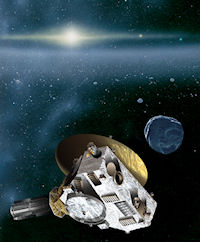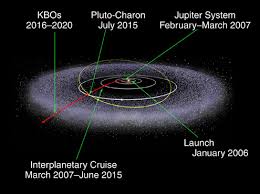More dramatic news from the far reaches of the solar system: NASA’s probe New Horizons has awakened from its nine year hibernation and is powering up to approach Pluto! Although it sounds like “New Horizons” is a boy band, NASA gave up on trying to launch every saccharine teenybopper act into the Kuiper belt (although that is a laudable goal): instead the probe is named after the fact that New Horizons is the first human spacecraft to explore the dwarf planet Pluto and its little moons Charon and Hydra. Launched in January of 2006, New Horizons set the record for the highest launch speed of a human-made object from Earth. The grand piano-sized spacecraft has spent the intervening years hurtling through the darkness of space–although it has periodically come to partial wakefulness to check in with mission control and to snap some dramatic flyby photos of famous locations along its trip (like this photo montage of Jupiter and Io). The craft also used Jupiter’s gravity well to increase its velocity.
Since the time the probe was launched, astronomers have discovered two new miniature moons of Pluto: Kerberus and Styx. This means that New Horizons mission planners were forced to assess the possibility of a catastrophic collision with unseen debris or dust left over from these satellites. Computer models suggest that the likelihood of such an accident is remote, but, just in case, NASA has added two dramatic contingency plans for the mission. In one emergency plan, the probe’s satellite dish acts as a dust shield, in the other, the craft drops dangerously close to Pluto, where atmospheric drag has presumably cleared the surrounding space of particles. These worst case plans will almost certainly not be needed, although we will learn more as New Horizons gets closer to the dwarf planet.
After flying past Pluto next July, New Horizons will hurtle into the Kuiper belt where NASA hopes the probe will rendezvous with an icy Kuiper belt object so that we can learn more about these enigmatic leftovers from the creation of the solar system. The coming 7 months should be filled with excitement as we learn more about the Pluto system!





4 comments
Comments feed for this article
December 8, 2014 at 4:26 PM
agnesashe
Let’s hope the probe now lasts longer than most boy bands!
December 8, 2014 at 11:30 PM
Wayne
Ha! It already has…(although it never made the cover of “Tiger beat”).
December 9, 2014 at 5:34 AM
Beatrix
Pluto almost looks to a robust, earthy yet tasteful hue of Marsala, êtes-vous d’accord?
Les goûts et les couleurs ne se discutent pas.
January 2, 2019 at 9:03 PM
Wayne
heehee…it does look a bit Marsala…I wonder if has updated to pale green and coral in the intervening years.